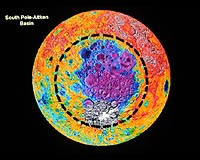 |
Washington DC (SPX) Aug 03, 2009 When President Kennedy announced on Sept. 12, 1962, that the United States would go to the moon before the end of the decade, life and work at NASA changed in monumental ways. By then, NASA had four manned spaceflights under its belt. A trip to the moon would leverage years of spaceflight knowledge, but traveling out of low Earth orbit, past Geosynchronous orbit to the moon, would demand increased launch and crew vehicle capabilities. The 4-year-old space agency would need to simultaneously develop lunar surface systems - extravehicular space suits, tools, communication systems and lunar rovers. NASA would also have to train its astronauts to land on the moon, navigate the surface and gather samples - all while documenting each step as the world anxiously waited. But how on Earth - literally - would NASA prepare its astronauts for the three-day, 250,000-mile trip and subsequent landing, exploration and extravehicular activities on the lunar surface? The answer was Geology Field Trips (GFTs). GFTs were conducted at remote locations that were chosen because geology, terrain or climate characteristics were similar to the moon's surface. In 1963, NASA sent Buzz Aldrin, Neil Armstrong and Michael Collins on a preliminary GFT at Cinder Lake near Flagstaff, Arizona. The three former military pilots practiced sample collection with special tools and used state-of-the-art communication systems. The GFTs continued until 1972 and included locations such as Hawaii, Minnesota, Nevada, New Mexico, Texas, Washington, the Grand Canyon, Canada, Iceland and Panama. Each GFT had unique objectives, including rock formation identification, sample cultivation, survival training and communication techniques. In 1969, just six years and ten months after President Kennedy's monumental announcement, NASA sent three well-trained astronauts to the moon and returned them safely back to Earth. "Embody a Sustainable Course of Long-term Exploration." In 2004, another historic presidential announcement declared that the United States would not only go back to the moon, but would also establish a sustained human presence there in preparation for further exploration into our solar system. NASA engineers, scientists and astronauts once again began to evaluate vehicle architectures and surface systems that would enable this new goal to become a reality. Apollo GFTs and lunar missions provided valuable data as NASA began preparation for the next generation of space exploration. New requirements and technological advances, however, demanded a new era of GFTs, called analog missions this time around. Present-day analog missions are conducted to test long- and short-range mobility, advanced communication and relay systems, spacesuits, surface operations, and local resource power generation and storage. Many of the same Apollo GFT locations are used for today's analog missions. To date, analog locations include Florida, Arizona, Hawaii, Washington, Antarctica and Canada. List of Current Analog Field Tests:
Advanced Navigation and Communication Submarine Field Tests During these long-duration missions, NASA executes a range of undersea "moon walks" that provide astronauts with a realistic approximation of situations they will likely encounter on the moon. These simulations help astronauts understand how to execute daily operations in a simulated partial gravity environment. Pavilion Lake, British Columbia, Canada The Pavilion Lake Research Project (PLRP), conducted in British Columbia, Canada by the Canadian Space Agency in collaboration with NASA, is a multi-disciplinary science and exploration mission to explain the origin of freshwater microbialites. NASA conducts analog missions at Pavilion Lake because the extreme, remote location provides a challenging setting to test and develop research and exploration methods. Collecting microbialite samples will help improve techniques for future space exploration missions and scientific research on the lunar surface.
Habitat Evaluation The analog also evaluated how easily a suited astronaut could assemble, pack and transport the habitat. If selected for future missions, the structure will reduce the amount of hardware and fuel necessary for transportation and logistics on the moon.
Surface Mobility Field Tests Black Point Lava Flow, Arizona - Phase 2 The terrain and size of Black Point Lava Flow provide an environment geologically similar to the lunar surface. It is here that NASA first introduced the Lunar Electric Rover, a conceptual vehicle with an extended range and the capability to travel rugged planetary terrain. The Black Point landscape enables the rover to undertake sorties (short field excursions) with ranges that extend greater than 10 kilometers (6.2 miles). The sorties tests include a 3-day exploration mission.
In-situ Resource Utilization The demonstrations help reduce risk to lunar missions by demonstrating technologies for end-to-end oxygen extraction and separation from the volcanic material, oxygen storage, and other technologies that could be used to look for water or ice at the lunar poles.
Haughton Mars Project: Extravehicular Activity Traverses, Long-term High-data Communication, Complex Robotic Interaction, and Onboard Rover and Suit Engineering. During the Haughton Mars Project, scientists, engineers and astronauts perform multiple representative lunar science and exploration surface activities using existing field infrastructure and surface assets. Share This Article With Planet Earth
Related Links Analogs field tests Mars News and Information at MarsDaily.com Lunar Dreams and more
 Maximizing Scientific Return Of The Moon Rovers
Maximizing Scientific Return Of The Moon RoversTucson AZ (SPX) Jul 28, 2009 NASA and other national space agencies are again focused on lunar exploration, which raises the question of how to best use semi-autonomous rovers to explore the Moon's surface. R. Aileen Yingst, a senior scientist at the Tucson-based Planetary Science Institute, is leading a group of Mars-rover veterans who are conducting field studies to answer that question. The scientists are ... read more |
|
| The content herein, unless otherwise known to be public domain, are Copyright 1995-2009 - SpaceDaily. AFP and UPI Wire Stories are copyright Agence France-Presse and United Press International. ESA Portal Reports are copyright European Space Agency. All NASA sourced material is public domain. Additional copyrights may apply in whole or part to other bona fide parties. Advertising does not imply endorsement,agreement or approval of any opinions, statements or information provided by SpaceDaily on any Web page published or hosted by SpaceDaily. Privacy Statement |